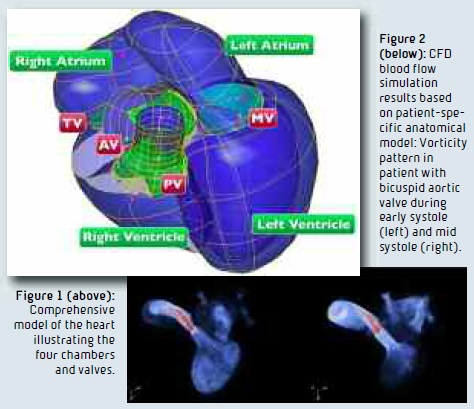➣ By William W. McFadden & Michael Suehling
The treatment of pediatric congenital heart disease is hampered by the scarcity of relevant cases, the lack of integrated data and the limited opportunities for clinical comparison among others. Yet, advances in pediatric cardiac surgery, interventional cardiology, intensive care and non-invasive imaging have led to a substantial increase in life expectancy for many patients with congenital heart disease. However, difficult challenges still persist due to the evolving nature of a child’s heart and vascular system.
Since the development of the project’s proposal, Sim-e-Child (SeC), a project funded by ICT for Health, European Commission, has aimed to improve clinical outcomes of pediatric cardiology patients. In order to achieve better and more reliable risk stratum, to improve and personalize therapies, and to ultimately increase the patient survival rate, SeC is focused on developing comprehensive and accurate computer models from patient-specific data and simulated physical constraints.
SeC aims to strengthen the impact of “Health-e-Child” (HeC), which was completed in April 2010. HeC had created an international simulation and validation environment for pediatric cardiology, supported by integrated data repositories. SeC is working to go beyond the state-of-the art by providing comprehensive and patient specific models for anatomy, function and hemodynamics of the left heart, with a focus on the congenital aortic arch disease and repair.
Sim-e-Child’s Grid Infrastructure
The first 16 months of work has seen SeC develop the first Trans-Atlantic platform for large-scale simulations in cardiology. SeC’s clinical applications are being built on an evolution of HeC’s original grid infrastructure based on the EGI Grid middleware (the gLite technology and European Grid Infrastructure – www.egi.eu) and the enabling GÉANT network, that together provide virtually unlimited computing power, data storage capacity and network bandwidth.
The early stages of SeC’s work also saw the conclusion of a significant infrastructure setup and migration, aimed at interconnecting HeC and SeC, with the ultimate goal of making HeC’s mature components sustainable and therefore, reusable in SeC, while giving SeC a significant technical basis onto which further expansion will take place for the duration of the project.
Sim-e-Child’s Web Portal
The SeC Web portal is now well advanced, and through public and private sections, is providing users with access to the grid and integrated applications. As a result of SeC’s first year’s work, the partners have started utilizing the high bandwidth pan-European GÉANT research network to:
- Establish a multi-site, web-accessible database of pediatric cardiology data, information and knowledge for translational research.
- Develop a grid-based platform, supporting the definition, execution and sharing of scientific cardiac modeling and simulations.
Some of the operational features include:
- The SeC Grid infrastructure and computing resources, using a standard and internationally recognized GridPMA certificate. The Portal is cross-platform and therefore works under MS W7/XP, major Linux distributions and Mac OS X.
- The SciPort database and interfaces for manipulating data and simulations’ outputs is being integrated to the security infrastructure so that it will be possible to enter Sci- Port directly once logged in the SeC portal.
By integrating the portal and the grid infrastructure, SeC will provide pediatric cardiology professionals in Europe and the U.S. with a Virtual Physiological Human based decision-support system and virtual laboratory. This will enable them to construct and validate multi-scale and personalized models of a growing child’s heart and blood vessels. Ultimately, this will support their clinical decisions and allow better understanding of their patient’s condition.
Sim-e-Child’s Heart Modeling Results of 2010
Besides technical interoperability requirements elicitation and infrastructure bridging, work focused also on the development and validation of a comprehensive cardiovascular anatomical model enabling first patient-specific hemodynamics simulations. The main achievements have been:
- The existing HeC heart models were validated by the clinical partners in the U.S. on MRI data from Tetralogy of Fallot (TOF) cases. Using linear regression and Bland Altman plots, left and right ventricular systolic (LV ESV and RV ESV), diastolic volumes (LV EDV and RV EDV) and ejection fractions (LV EF, RV EF) were compared between manual and automated methods.
- The existing HeC heart models were extended by integrating and enhancing existing Siemens Corporate Research models, of the aortic and mitral valve. To exploit the morphological, functional and pathological dependencies and variations of the different heart valves, the pulmonary valve (PV) and tricuspid valve (TV) have been modeled, in addition. The heart valves represent a critical component for the analysis, modeling, and simulation of the whole heart function and this work represents the first data-driven modeling of the complete valvular apparatus.
Patient-Specific Cardiac Blood Flow Simulations
Clinicians at SeC’s clinical centers were provided with the first, simulated, patient- specific cardiac blood flow across the entire cycle. Thanks to this work clinicians will, for instance, benefit from a better understanding of the vorticity which can convey crucial information about the formation and dynamics of potentially harmful “spins.” By integrating these elements, SeC will provide pediatric cardiology professionals in Europe and the U.S. with a Virtual Physiological Human based decision support and virtual laboratory. This will enable them to construct and validate multi-scale and personalized models of a growing child’s heart and blood vessels. Ultimately, this will support their clinical decisions and allow better understanding of their patient’s condition.
William W. McFadden
Lynkeus
Italy
Michael Suehling, Ph.D.
Siemens AG
Germany
michael.suehling@siemens.com
About Brenda Wiederhold
President of Virtual Reality Medical Institute (VRMI) in Brussels, Belgium.
Executive VP Virtual Reality Medical Center (VRMC), based in San Diego and Los Angeles, California.
CEO of Interactive Media Institute a 501c3 non-profit
Clinical Instructor in Department of Psychiatry at UCSD
Founder of CyberPsychology, CyberTherapy, & Social Networking Conference
Visiting Professor at Catholic University Milan.







